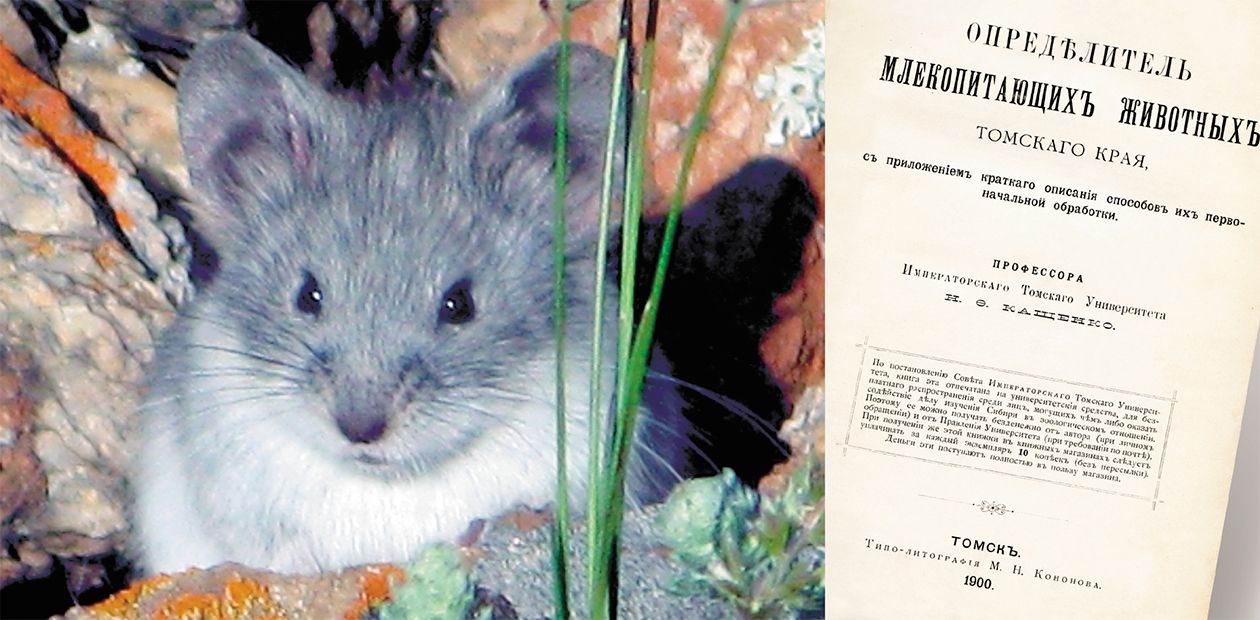Mumiyo Made by the Mountain Vole
Although studied quite well, this cute small animal, an ancient inhabitant of GornyAltai and Tuva, is still surrounded by numerous myths and enigmas. The main among them is its association with mumiyo, a well known ancient remedy still common in pharmacology and medicine
Studying the fauna of the Sailyugem Ridge (Gorny Altai), an expedition of the Institute of Systematics and Ecology of Animals discovered, in 1990, large colonies of cute light-colored animals at a latitude over 2000 m. The inhabitants of a large boulder stream (a steep mass of loose rock on the slope of a mountain) were busily storing rather scarce mountain vegetation into small stacks. The animals were not afraid of people and displayed a diurnal activity, untypical of other voles.
The researchers appeared to come upon the flat-headed vole (Alticola strelzowi, 1901), discovered at the end of the 19th century by N. F. Kastschenko, a well-known Siberian biologist. A longstanding interest of zoologists in this species is connected with mumiyo: a comprehensive study of these inconspicuous rock dwellers could help solve the enigma of, the substance of lasting legendary reputation.
Streamlined “biotechnology”
Mumiyo is a word of Greek origin meaning “saving the body.” Ancient physicians used it for healing numerous diseases and improving the general vitality. Dozens of ancient manuscripts give rich material on the application of mumiyo as a biological stimulant of the widest range. Currently, mumiyo is common in both folk and traditional medicines, in particular, for healing bone fractures, gastrointestinal ulcers, and so on.
The flat-headed vole was discovered by Prof. N. F. Kastschenko, a well-known biologist. Nikolai Feofanovich had a brilliant biomedical education and experience as a lecturer at Kharkov University, well-known at that time. After defending his Doctor of Science degree in 1889, he moved to Tomsk to become the first professor in zoology at the recently founded Tomsk University.From the very beginning of his scientific career, Kastschenko was attracted by the richness and diversity of the fauna in this region, insufficiently studied at that time. He commenced studying the Siberian fauna and later published over 50 papers in this field; in 1887, he organized a zoological museum with Tomsk University.
In 1890, Kastschenko’s paper titled The Goals of Zoology in Siberia was published, where he proposed a plan for zoological research in the field of the so-called applied zoology, systematic zoology, zoogeography, and preparation of the keys to individual animal groups. According to this plan, field expeditions were sent to remote sites of Siberia to sample zoological material. The new vole species was discovered in 1898 by one of the expeditions to Central Altai.
In 1900, Kastschenko published The Key to the Mammals of the Tomsk Krai, which later became the first handbook of this kind in Russian. The later keys to mammals referred to this work by Kastschenko and went by his numerous publications
Mumiyo is a mixture of organic and inorganic substances readily soluble in water; it is harvested in mountains and caves of Central Asia, where it accumulates in rock cracks and cavities as films or crusts. The origin of mumiyo is still a riddle despite numerous hypotheses trying to explain it.
The mumiyo of animal the origin we are dealing with here is found in the mountains of East Kazakhstan, Altai, and Tuva and is directly associated with the flat-headed voles.
Participants of this expedition found rather large heaps of clumped droppings under boulders in steep clefts. It is likely that from year to year the voles use the same sites for their “WCs.” At the places where these droppings are well lit with the bright mountain sun, they “melt” with time and flow downslope as a uniform black-brown mass with a specific odor. This is an almost pure mumiyo.
The major initial substances for mumiyo are undoubtedly components of alpine plant species constituting the vole’s diet. This is not obligatory juniper, as is stated by P. U. Marikovskii (1991), a known Russian zoologist. Presumably, of great importance are shrubby forms of various wormwood species, which voles store along with other plants and which have a strong odor similar to that of mumiyo.
It has been long known (Ognev, 1950) that wormwood stems with mature seeds account for a considerable part of the vole’s feed stores. Zoologists from the Institute of Systematics and Ecology of Animals identified shrubby wormwood species forming the core of high-latitude plant communities – Artemisia santolinifolia, A. frigida, and A. depauperata – in the specimens of flat-headed vole’s winter stores in the region of the Sailyugem Ridge. In addition to wormwoods, these feed specimens contained over 30 plant species.
The wormwoods are very rich in volatile oils. At the first stage of the mumiyo production “biotechnology,” the plant material rich in volatile oils, other useful substances and trace elements is digested in the vole gastrointestinal tract. Further processing of clumped droppings is made by the sunshine and mountain air, poor in oxygen.
The vole: yesterday and today
The current habitation area of the flat-headed voles is the mountains of Central Asia. In Gorny Altai and Tuva, this species inhabits the alpine tundra-steppe, where suppressed tree and shrub species characteristic of plains grow along with the tundra species and subalpine vegetation conjoins steppe species. The vole populations vary a lot in size; the most numerous in the habitats covering large areas, where the rocks and boulder streams are close to one another.
It is known that in the Pleistocene the biocenoses characteristic of mountain voles – petrophilic rockscapes of steppe type – occupied larger areas than now. In particular, the mountain voles were one of the most abundant groups of mammals in the Pleistocene cave deposits of Gorny Altai, accounting for up to 15 % (Agadzhanyan et al., 2006).
Both small plant-feeding animals (first and foremost, pikas and ground squirrels, living immediately near vole habitats) and larger mammals (tolai hares, marmots, and argali, feeding the same diet) are food competitors for voles.
Also, our voles are dear to the taste of many predators, especially Pallas’ cats and steppe polecats living in the mountains of Altai and Tuva. In the case of a large population size, the flat-headed voles can be a major contribution even to the snow leopards’ diet. Numerous birds of prey living in the mountains also hunt voles – first and foremost, the black kites and other raptors common for this area, namely, eagles, owls, and pygmy owls. In the Kazakh Upland, voles can fall pray to a Dione ratsnake or a steppe viper.
Recently, expeditions of the Institute of Systematics and Ecology of Animals have outlined the current areas of the flat-headed voles and obtained new data on the specific biological features of this species. In particular, it has been found that two well distinguishable morphological forms of the vole have established: namely, the Kazakh–Altai group, occupying the larger part of the habitation area in the east, and the Central Altai (Tuva–Mongolian) group, living in the northwestern part of the area.
Studies into the systematics and ecology of these animals, interesting not for zoologists only, continue.
References
Agadzhanyan A. K., Derevyanko A. P., and Shun’kov M. V. Problems in the Relationships between the Prehistoric Man and Natural Environment by the Example of Northwestern Altai // Evolution of Biosphere and Biodiversity. M.: KMK. 2006. P. 439—459.
Kastschenko N. F. The Key to the Mammals of the Tomsk Krai. Tomsk, 1900.
Litvinov Yu. N., Erzhanov N. T., Lopatina N. V., and Abylkhasanov T. Zh. New Data on Small Mammals of the Kazakh Uplands // Sib. Ekol. Zh.. 2010. No. 5. P. 807—812.
Marikovskii P. U. The Truth about Mumiyo // Khimiya i zhizn’. 1991. No. 11. P. 62—64.
Markevich A. P. and Kvitnitskii-Ryzhov Yu. N. Scientific Activities of N. F. Kastschenko in the Field of Zoology // Izv. Akad. Nauk SSSR, Ser. Biol. 1951. No. 4. P. 14—22.
Ognev S. I. Animals of the USSR and Neighboring Countries. Rodents. M.-L.: Izd. Akad. Nauk SSSR. 1950. V. 7.
Pozdnyakov A. A., Litvinov Yu. N., and Lopatina N. V. Ecological and Morphological Variation of the Flat-headed Vole (Alticola strelzowi Kastschenko) Altai Populations // Sib. Ekol. Zh. 2004. No. 4. P. 579—587.
Photos are courtesy of the authors













